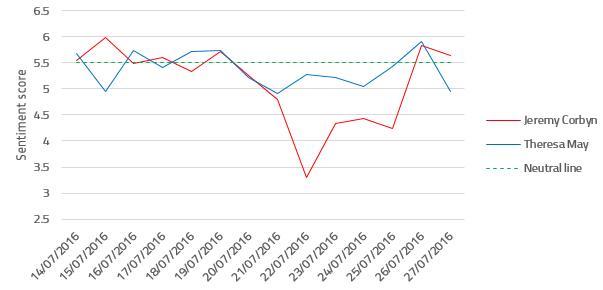Reviewing Theresa May’s first fortnight as Prime Minister – analysing public reaction
A recent poll by The Times indicated that there were millions of previous Labour voters who thought that Theresa May would be a better Prime Minister than Jeremy Corbyn. This would appear to be another victory for May following the praise she received for her performance in her first Prime Minister’s Questions.
To understand more about the perceptions for both May and Corbyn, we’ve analysed 135,000 pieces of public data related to both politicians in the fortnight since May became Prime Minister, covering:
- How has sentiment towards Theresa May shifted since she became Prime Minister?
- How does sentiment towards Jeremy Corbyn compare?
Figure i: Sentiment trends for Theresa May and Jeremy Corbyn*
If we initially focus on Theresa May, we can see that she has had a reasonably smooth start. There are no major dips in sentiment, but neither have there been great successes, reflected in a below neutral average sentiment score of 5.38. However, within the context of the turbulent political and business landscape caused by the Brexit vote, May’s relative stability is a success in itself.
In contrast, Jeremy Corbyn’s average sentiment is lower than May’s at 5.11, with more pronounced dips, especially on July 22nd. This slump lasted four days and followed his poor PMQs performance as well as being affected by negativity connected to over 40 female Labour MPs urging Corbyn to do more to tackle “escalating abuse and hostility” towards MPs.
However, sentiment to Corbyn has recovered in recent days, and overtook May’s by 13% on 27th July. This would indicate that while May is generally preferred to Corbyn, he still has ample support, and public opinion against him is tnot as pronounced as some polls would suggest.
*Footnote: The methodology – how do we calculate sentiment scores?
The alva algorithm calculates sentiment scores out of 10, where a score of 5.50 is considered neutral. The algorithm takes into account the volume, influence, prominence and relevance of real-time mentions from 80,000+ news sources, more than 3m blogs and forums, 100+ social networks. A score above 6.00is considered strong, while a score below 5.00 is considered weak.
Be part of the
Stakeholder Intelligence community












